The Outer Banks of North Carolina — a chain of beach-lined barrier islands stretching for over 100 miles — might as well be called the “Adventure Capital of the Atlantic.” It’s here that high sand dunes roll and whip in the wind, wild horses roam, inland forests hide rare birds and wildlife, and kites and kayaks are common modes of transportation.
Made up of small, historic towns and villages — all of the OBX has only 50,000-some residents — no season is crowded or rushed. But the outdoor adventures? Those can be as fast-paced as you can handle. When you’re ready to take to the sea, the sand, or the skies, here’s how to satisfy your appetite for adventure.
Hit the water — and fly.
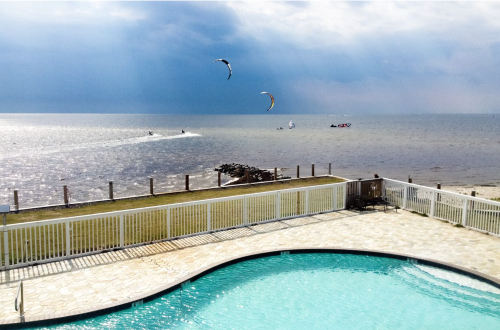
There are as many methods of getting on the water in the Outer Banks as there are environments. In creeks and estuaries, from surfside to soundside, you can ply the waters with a kayak, canoe, standup paddleboard (SUP), kiteboard, pontoon, catamaran — or, in some cases, you could just hop in.
But say you want to go fast. This is the spot to try out kiteboarding and windsurfing — the combination of colliding ocean currents and their breezes creates the ideal environment for harnessing the wind and taking flight. There’s a reason, after all, that the Wright Brothers tested out their contraptions right here.
If you’re on the fence about taking a lesson — outfitters abound and know to expect true beginners — the annual OBX-Wind Competition will either serve as serious inspiration or convince you spectating is your thing. Over the course of a week in November, the pros gather on the open water to freestyle, slalom, and race to the finish line.
Hit the water — with a paddle stroke.

But back to slowing down. While the Outer Banks itself is a maze of waterways worth a paddle, there are a few spots that bubble up to the top of the list again and again:
- Alligator River National Wildlife Refuge has over 15 miles of paddling trails. They’re color-coded on the map, so all you have to do is choose what suits you and head out. Keep your eyes peeled, as the area is home to black bears, bald eagles, rare woodpeckers, and, yes, the ancient, leathery creatures that give the refuge its name.
- Cape Hatteras National Seashore runs all the way from Bodie Island to Ocracoke, and put-ins can be found up and down the Roanoke and Pamlico sounds. The area around Bodie Island is particularly special, as you have a smattering of islands and marshes hiding abundant local flora and fauna.
- Kitty Hawk Woods is one of the most pristine stretches of maritime forest left in the country, if not the world. SUPing along the four-mile High Bridge Creek and the marshes and estuaries — watching for turtles, salamanders, hawks, ospreys, grey foxes, and muskrats — feels like a private wildlife tour on your own time.
Tour the country’s best lighthouses.

Some of the most iconic lighthouses in the United States rise high above the North Carolina coast, with the greatest concentration in the Outer Banks. Picture a lighthouse, and you might be picturing one that’s right here.
Let’s start with a fan favorite: Cape Hatteras Lighthouse, adorned with distinctive black and white barber-pole stripes. It may not be the oldest in the state, but it is the tallest brick lighthouse — on the continent. Though it dates back to the 18th century, it was moved to its present location in 1999.
Meanwhile, horizontal black and white stripes — these bold color patterns enable mariners to spot the lights easily — cover Bodie Island Lighthouse, just south of Nags Head. Watching over the treacherous stretch of open water known as the “Graveyard of the Atlantic,” it’s tucked into marsh and pine, giving it a uniquely OBX feel.
Both lighthouses are climbable seasonally — at least, most years — usually beginning in April. Check their respective websites for details on openings, but know that simply walking in the shadow of these sentinels can leave any visitor in awe.
Hang-glide off the sand.
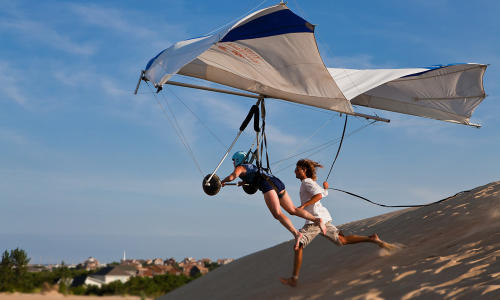
Imagine experiencing the same exhilaration the Wright Brothers must have felt when they took to the skies for the first time. You can get a taste of that exact sensation hang-gliding at Jockey’s Ridge State Park, catching some air right off the immense dunes.
A lesson with Kitty Hawk Kites is around three hours long: You’ll start strapped in, knees in the sand, until you’re ready for your running start, the guides helping you gain speed and take off. If you don’t land on your feet the first few times, know that’s totally normal — and the sand is cushion-soft.
Spend dawn and dusk with rare and endangered birds.
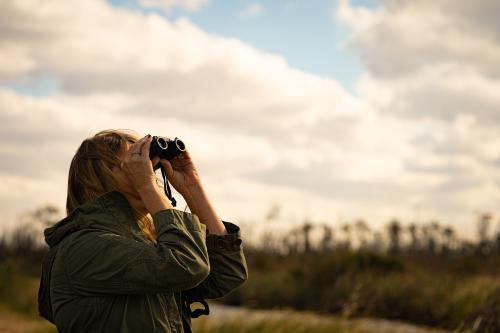
While North Carolina touts itself as “First in Flight,” more than 400 species of the original aviators call this region home, from backyard faves to rare and endangered. Bring your binoculars to these wild spots:
- Thousands of greater snow geese, along with a myriad of other migratory waterfowl, flock to Pea Island National Wildlife Refuge for the winter — across the seasons, Pea Island sees the vast majority of the Outer Banks’ 400+ species. Keep your eyes peeled for rare ones likes the piping plover, peregrine falcon, American oystercatcher, and least tern.
- Nags Head Woods Preserve is one of the largest remaining tracts of maritime forests on the East Coast, its towering sand dunes allowing massive oak, hickory, and beech trees to thrive, creating a rare ecosystem. Throughout the year, birders have the opportunity to spot 150+ species — during the summer, look for brightly colored migratory birds from Central and South America, like prothonotary warblers and blue grosbeaks.
- Located just across the bridge on the mainland, Alligator River National Wildlife Refuge provides habitats for 250+ bird species, including rare and endangered woodpeckers, short-eared owls, bald eagles, and tundra swans. Bonus: One of the largest concentrations of black bears in the southeastern United States can be found here, too.
- On the north end of Roanoke Island, enjoy a bird bounty of cardinals, finches and chickadees with a stroll through the forests of Fort Raleigh National Historic Site. The 1.25 mile Freedom Trail honors one of the first Freedman’s Colonies of African Americans that was established nearby in the early days of the American Civil War where runaway and emancipated former slaves could live free. At the trailhead, the William B. Umstead bridge is the summer home to millions of purple martins, a popular evening observance as they return home to roost at dusk.
Sit deep in the saddle.

Perhaps you’ve ridden horseback in the mountains, across meadows or vineyards, but there’s something wild and free about riding on the open sand, into the salty breeze. Buxton Woods Coastal Reserve and Cape Hatteras National Seashore — America’s first, by the way — provide that rare combination of both dense maritime forest and beach, and outfitters offer rides through it all.
Tours typically last around two hours, and while most operators have age and weight restrictions (both for the safety of the rider and the health of the horses), experience isn’t essential. Of course, if one member of your crew has the skills to ride and carry a camera, that doesn’t hurt.
Hike from forests and dunes to marshes and open beaches.
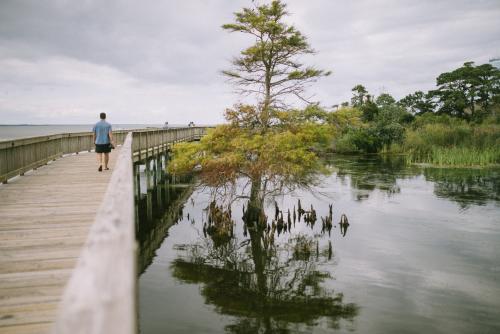
You’ve just spent the past five minutes reading up on sand dunes, maritime forests, wildlife preserves, marshes, estuaries, and rivers — hopefully it’s clear by now that nature runs amok on The Outer Banks of North Carolina. Hiking trails run amok, too, and here are some spots you’ll want to hit with your own two feet:
- At Nags Head Woods Preserve, you get history and wildlife alongside the sand dunes, ponds, and marshes. The two-mile Sweetgum Swamp Trail is a decent cardio workout.
- At Cape Hatteras National Seashore, you could simply walk the beach until your feet give way, but the 4.5-mile Open Ponds Trail mixes up your terrain, bringing interdune ponds and maritime forest into your sights.
- The Sea Breeze Trail through Hatteras Village Park and the Duck Boardwalk are both kid- and stroller-friendly, with playgrounds, marsh and forest views, and shops (and donuts!) to hold tiny ones’ attentions.
Angle away the afternoon.
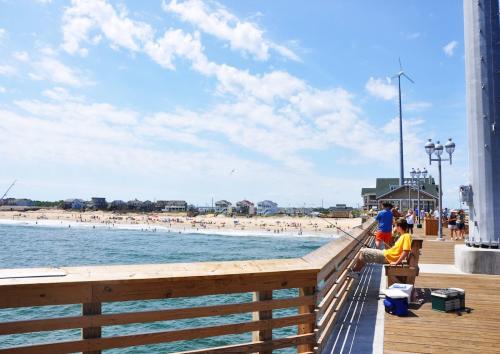
Walk out onto the 1,000-foot-long Jennette’s Pier, and it should become clear pretty quickly that the angling here is top-drawer. And not just from the piers! There’s fly fishing, brackish fishing, charter fishing (offshore and inshore), sound fishing, surf fishing, and a few others — but to keep it simple, know that piers often offer rentals and are covered under a blanket license, and the season starts in March with sea bass, bluefish, tuna, and snapper the standard catches. (Otherwise, you’ll need a fishing license to go out on your own.)
What you want to do will determine where you should go, but so too will the wind and weather. If you’ve got your own gear and license, your best bet is to book an outing with a guide and let them show you the treasures just below the water’s surface. Expect to see trout, sea bass, striped bass, bluefish, tuna, white marlin, blue marlin, wahoo, cobia, king mackerel, flounder, snapper, grouper, crab, shrimp, bay scallops, and oysters.
Tip: Speaking of scallops and oysters, if it’s fresh seafood you’re after, consider attending Taste of the Beach. It’s three April days of endless cracking, slurping, and sampling the freshest seafood from the area’s favorite restaurants.
Bike the nature preserves, forests, and beaches.

From Duck to Hatteras Island, there are just as many miles of bike paths as there are beaches. Nearly every town or village is marked with multi-use paths, and the open back roads of farm country and wildlife preserves naturally lend themselves to two-wheeled exploration.
With the exception of a few bridges, the Outer Banks are flat and family-friendly. But the experience is hardly uniform, as you pedal from the sand to the sound, from the forest to backwater marshes, from boardwalks to the beach and back again. That being said, there might be one thing that always follows you, wherever you go: the sea breeze. ![]()

